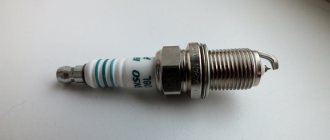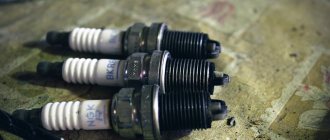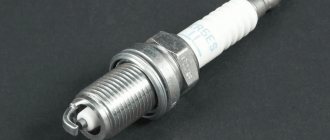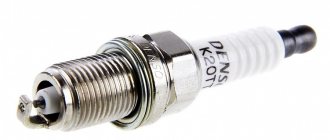Many novice drivers who have recently become owners of a car do not know what the heat rating of spark plugs is. This parameter is considered the most important, as it shows which t will provoke spontaneous ignition. During Soviet times, a single table was created that displayed “cold” and “hot” heat numbers. At this point in time, there is no one-size-fits-all chart because different manufacturers label them differently. Let's look at this issue and understand it better.
What are spark plugs?
A gasoline engine will not start without spark plugs. These elements are special parts that work in the car’s ignition system. The spark plugs are placed above the cylinder with one end into the motor and the other on the high-voltage wire.
Candles are necessary to ignite gasoline in the combustion chamber (combustion chamber). The element consists of a large number of parts, including a contact rod and tip, an insulator, a resistor, several washers and an electrode.
If the spark plugs are not properly tightened, the engine may not function properly. Weak tightening reduces compression in the combustion chamber, and strong tightening leads to deformation.
The main parameter of spark plugs is the spark gap. It is this that shows the distance between the electrodes and causes a spark to form. If the gap is too large, then there will not be enough energy and the mixture will not ignite. However, a small gap, on the contrary, will provoke burnout of the electrodes.
Important factors for efficient engine operation
In order for engine power to be provided to the fullest extent and at the same time comply with environmental standards, so that the smooth operation of the engine is maintained, several important conditions must be met.
Thus, the cylinders must be filled with the correct and precise amount of a properly balanced mixture of air and gasoline. The spark that will ignite the combustible mixture must pass between the two electrodes only at exactly the right moment, and at the same time have a certain power.
What does heat number mean?
Let's consider what the spark plug heat number (CN) shows. CN is a parameter that determines the thermal characteristics of an element. In other words, it shows the pressure value in the combustion chamber at which spontaneous ignition of the mixture will occur. The lower the value, the slower the spark plug warms up during engine operation.
While the engine is running, the spark plugs become hot. When their temperature reaches the “working” temperature, they are “freed” from carbon deposits. When overheated, the mixture ignites, but not from a spark, but from the hot surface of the element. If in ancient times there were “engines” that started working only after glow ignition, now there are no such things.
In fact, this is a very negative process because the mixture ignites at the wrong time. Accordingly, the internal combustion engine begins to work incorrectly. This leads to severe power loss and additional load. Sometimes untimely ignition occurs due to incorrect selection of spark plugs or after they break.
From spark to heat one step
The spark mode of operation of the spark plug has a double effect on the operation of the spark plug itself. On the one hand, gradual heating promotes self-cleaning of the part from fuel impurities, which is of particular importance in domestic realities. But if the temperature of the spark plug continues to rise simultaneously with the degree of fuel compression, when it passes 900 degrees it turns into a glow plug. Control over the timing of ignition is lost, and the load on the engine increases sharply.
In motor vehicles, glowing spark plugs can cause serious consequences, including costly engine repairs. The only exception is operating transport models, where a glow plug serves as a heating element for a kerosene engine. Its operation is short-term - subsequently the engine operates due to the high temperature of the fuel mixture.
Many scientists were called to solve the problem of scuffing on the cylinder block due to incandescence. The result was a heat rating that corresponds to the maximum pressure level in the cylinder. It directly depends on the boost pressure.
What does the heat number affect?
Heat rating is a complex term that is difficult for most drivers to understand. If you present this word in simple language, you will get a more understandable term. CC shows the time. When it expires, the spark plug will go into a glow state and trigger it.
This is a universal value that is suitable for different types of engines. The parameter is expressed in numbers from 11 to 26. The number indicates the parameter and at the same time shows the minimum pressure required to create ignition in the combustion chamber.
Determining the number is not so easy, since there are no uniform standards for definition. The figure is established during testing on special equipment. Spark plugs from foreign manufacturers do not contain a heat rating. This is due to the fact that they are installed on certain internal combustion engines, which means that there is no need to conduct experiments to determine the parameter.
Different types of engines have different temperature rises, which is why components with different CNs are used. They are compared with the motor load. The optimal heating parameter on the insulator is 400-850 °C. If the heating temperature is above the specified range, then glow ignition occurs. It provokes the destruction of the electrodes, but at the same time the components are cleaned of carbon deposits.
In any case, the driver should not allow overheating. The ignition timing changes, and the crankshaft “jerks” in such a way that it can tear the engine apart. The heat rating was precisely invented for the purpose of identifying the moment of engine failure.
Made in Russia
With the candles produced by the company over 110 years, if laid out in one line, it would be possible to encircle the globe several times or lay out (with a margin) a path to the Moon. Their production is concentrated in Germany and the BRIC countries - Brazil, Russia, India and China. Everywhere there is one plant. The company in the German city of Bamberg, in addition to large-scale production of the most modern products, concentrates research and development work and the headquarters of the company's candle production. At the rest, including the plant in Engels, Saratov region, mass and small-scale products are produced according to Bosch standards and specifications, consumed both in local and foreign markets. The Russian plant, in particular, exported 11% of its products in 2009. Two years later, that figure had risen to 47%. In 2010, 4 million Russian-made candles were sold in the United States and another 2 million in other countries.
The Age of the Bosch Spark Plug - 1902–2002 © Photo: Bosch Automotive
The task of the organizers of the press tour was a clear desire to emphasize that the plant in Russia is in no way inferior to the German one. I testify: the production in Engels is equipped with the same modern equipment, it is just as clean and even more spacious than in Bamberg, which suggests the possibility of further development of the enterprise on the existing premises. By the way, on an area of 191,000 m2, the production premises of JSC Robert Bosch Saratov occupy 33,000 m2. Of the 1046 employees, only 9 are foreigners. These are managers, including the General Director and Quality Director, and some specialists. In addition to spark plugs, the plant produces mass air flow sensors, electronic gas pedals, electric fuel pumps, fuel rails, central single injection modules, in-line injection pumps, wiring harnesses and connectors.
The enterprise has norms and standards common to all divisions of the company. In addition to inspections by our own quality control department, centralized quality control is provided: product samples from each batch are delivered for testing to Germany.
The main differences are a certain limited range of products manufactured near Saratov and the functions of the local development department. Germans keep their main secrets at home.
Russian engineers were entrusted with issues of materials science, analysis of complaints and serial support for spark plugs (with the creation of a special measuring laboratory), and to console creative pride - the development of industrial spark plugs and spark plugs of the EZ and APS brands for the local market. These stamps went to the company along with the Soviet plant that produced them. The candles were quite decent for their time, but there was still a quality problem: they either worked fine or didn’t work at all. It’s interesting how our brands will develop “under the hood” of Bosch.
Raw materials for insulators, central electrodes, tools and gauges for the production of main products are supplied from the German plant. Some of the equipment came from there, the other part was manufactured by the company’s traditional suppliers. All assembly lines have been moved from the Bosch plant in Bamberg. The quality control systems are identical, but some of the automated measurements in Bamberg are carried out manually in Engels. Loading and loading operations also differ in some stages in a similar way.
Bosch automotive products: multimedia systems, braking systems, electric drives, steering systems (50% owned by Bosch), stabilization and directional stability systems, diesel injection systems, starters and generators, gasoline injection systems © Photo: Bosch Automotive
The German plant focuses on high volumes and production for delivery to the assembly line and service network (OE/OES). The production line in Russia is easily rebuilt to produce small batches of products. The high quality of the products can be confirmed by the fact that in 2011 JSC Robert Bosch Saratov received permission to supply to GM-Opel Europe and Ford Europe.
To summarize the comparisons, let’s say: paying attention to the “Made in Russia” inscription is nice, but from a practical point of view it is pointless. Much more important is the Bosch logo and the marking of a specific candle. Moreover, the company may not produce the candle you need in Germany at all.
How to find out the heat number?
There is a classification of heat ratings, but there is no single system for all engines. Most manufacturers use the DENSO classification, in which the numbers range from 12-28. There is also a spark plug heat rating table according to NGK.
It is difficult to calculate the amount of heat that the spark plug removes from itself to the cylinder block body. This is due to the fact that the process occurs differently.
Thus, it is difficult to find out the value of the CN. But in the Soviet Union there was a single gradation in the range 8-26. Hot candles had a value of 11-14, cold candles were marked with numbers from 20 and above, medium ones had parameters of 17-19, and unified ones - from 11 to 20.
Other countries have their own labeling procedures that differ from the information presented above. In Japan and European countries, manufacturers reduce the number of spark plugs as heat increases. In America the situation is the opposite. The lower the number, the colder the element. To understand the markings, you should look at the end of the central electrode. If the CN is selected correctly, a blue ring will appear around it.
If the electrodes are burned out and the insulators are melted, it means that the CN was chosen incorrectly. The candle turned out to be too hot.
Compatibility table
The figure located above these lines will help us figure out which heat rating is suitable for a certain type of transport.
- Hot - used in everyday cars, that is, in those that most of us drive).
- Medium - used in engines not suitable for boosting.
- Cold - suitable exclusively for powerful engines, found mainly in sports cars.
However, this scheme does not solve the issue of compatibility of foreign candle models with domestic analogues. How to find out an existing alternative, for example, to the good old model “A10N”? Calm down, below I suggest you familiarize yourself with another table! She will definitely answer all your questions!
Causes of glow ignition
Glow ignition occurs when the spark plug overheats and causes the mixture to ignite earlier than expected. But this term should not be confused with detonation. The glowing element of the spark plug is usually the insulator. Every specialist knows the reasons for incandescence:
The insulator overheats due to the installation of a coolant with an incorrect temperature control.
An incorrectly configured ignition system also leads to overheating. Combustion moved to an early phase causes the elements to heat up.
If the vehicle was operated at high speeds for a long time, the system parts could not cool, which led to overheating.
Incorrect adjustment of the gas distribution mechanism. Gases are released through the hole, but it does not close completely. The exhaust valve or piston is overheating.
It is difficult to determine the symptoms of glow ignition, since the signs may indicate other problems with the car. Experts note that power failures most often occur at high loads, as well as a dull knock in the power unit. The symptoms can only be recognized when driving at high speeds.
Consequences
Glow ignition (KI) is considered a negative process. Its main disadvantage lies in the fact that combustion occurs spontaneously and it is impossible to control the process. Ignition does not begin at the right time, which provokes an increase in pressure and t in the chamber. Accordingly, the combustion phase in the remaining engine operating cycles shifts. If the car owner ignores the problem, the power unit will be damaged and stop working.
Let us list the main consequences of QoL:
For spark plugs, the integrity of the electrode and insulator will be compromised.
The piston crown will burn out.
The piston group parts will jam.
Piston scuffing will occur.
The consequences are not the most pleasant for both the engine and the car owner.
Made by Bosch
The production volumes of spark plugs, like the entire more than century-long history of Bosch spark plugs, are impressive, but the range of products produced may seem quite modest. These are the candles:
— with a central electrode doped with yttrium and a pointed profiled side electrode; — with 4 side electrodes and a pointed silver-plated central electrode; — with a copper core in a wear-resistant anti-corrosion chromium-nickel shell; — with a central platinum electrode tipped with yttrium alloy; — with central and side electrodes coated with platinum; — with a central electrode made of solid silver; - with a central electrode made of a platinum-iridium alloy, with a diameter of 0.6 mm.
All of them are designed for gasoline engines of passenger cars and light commercial vehicles. Bosch spark plugs cover 98% of the vehicle market.
In addition, for engines running on compressed natural and liquefied petroleum gas, special spark plugs of standard design and spark plugs with electrodes made of noble metals are produced. Small engines used in gardening and construction tools and other small-scale mechanization devices have not been forgotten either. Spark plugs for them have a chromium-nickel side electrode and a nickel-plated body.
The Bosch Super family of spark plugs is a “standard program” that covers the needs of almost the entire European fleet of passenger cars and light commercial vehicles. The copper core, which dissipates heat well, is enclosed in a wear- and corrosion-resistant chromium-nickel shell. The number of products produced goes into the billions. The spark plugs meet the requirements of car manufacturers for original components, incl. according to service life. The gap is set at the factory. Reliable sparking contributes to stable engine operation in all modes, increases its efficiency, reduces fuel consumption, reduces harmful emissions, and also protects engine parts and the catalytic converter from damage.
The universal Bosch Super plus program covers the needs of the car market by 95%. The central electrode is doped with yttrium, the side electrode has a pointed profile. The candles are distinguished by exceptional wear resistance and corrosion protection.
The central electrode of the Bosch Platinum spark plug is made of yttrium alloy with platinum soldering. The main advantages are high reliability of ignition of the combustible mixture, corrosion resistance and a service life of up to 60,000 kilometers without maintenance. It is noteworthy that the company spends more platinum on the production of Platinum series candles than the entire jewelry industry in Europe combined.
The central electrode of the Bosch Platin-Iridium spark plug is made from a platinum-iridium alloy for maximum durability and wear resistance. The optimal solution for gas engines.
Bosch Super special special purpose spark plugs are intended for motorcycles, snowmobiles, garden equipment, boats, chain saws, etc. They are characterized by excellent starting characteristics throughout their service life and effective protection against corrosion and thread seizing.
The Bosch Super 4 spark plug has 4 thin side electrodes and a pointed silver-plated central electrode. Reliable ignition is ensured thanks to an air-surface discharge: the arc is guaranteed to occur in one of eight possible spark gaps. The effective power of the spark plug is increased by 60%, which not only improves the process of ignition of the working mixture, but also promotes self-cleaning from soot.
How to avoid or correct a short circuit?
Having learned what the heat number of spark plugs affects, drivers should think about how to avoid short circuits. It is not difficult to eliminate the problem. But this must be done before negative consequences arise. First you need to remove the old spark plugs and replace them along with the insulators. If this does not help, then you should contact a professional workshop with a request to check the correct settings of the mixture ignition mechanism. To prevent short circuits, the driver needs to remember that they should not operate the car at high speeds for too long. You need to allow the engine to rest from time to time.
To ensure that the fuel-air mixture ignites only from a spark, it is necessary to check the spark plugs for carbon deposits. It is capable of overheating more than an insulator. It is important to correctly configure the ignition mechanism. There is no need to allow a shift to the early phase. The gas release mechanism must also work correctly. It is not recommended to configure it yourself.
Let's sum it up
Many drivers do not know what the heat rating of spark plugs is. However, in our article we have clarified this. Unfortunately, car owners often encounter glow ignition, which has a lot of unpleasant consequences. This is a spontaneous process that occurs at the wrong moment. It often leads to burnout of certain elements, such as the exhaust valve or pistons.
Thus, having become the owner of a new car, the driver should study this issue more carefully in order to avoid troubles in the future.
| Tweet |










